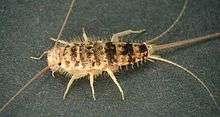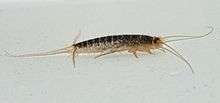Zygentoma
Zygentoma are an order in the class Insecta, and consist of about 550 known species.[2] The Zygentoma include the so-called silverfish or fishmoths, and the firebrats. A conspicuous feature of the order are the three long caudal filaments. The two lateral filaments are cerci, and the medial one is an epiproct or appendix dorsalis. In this they resemble the Archaeognatha, although the cerci of Zygentoma, unlike in the latter order, are nearly as long as the epiproct.[3]
| Zygentoma | |
|---|---|
 | |
| Thermobia domestica, a firebrat, typical of the order Zygentoma | |
| Scientific classification | |
| Kingdom: | Animalia |
| Phylum: | Arthropoda |
| Class: | Insecta |
| (unranked): | Dicondylia |
| Order: | Zygentoma Börner, 1904 |
| Families | |
Until the late twentieth century the Zygentoma were regarded as a suborder of the Thysanura,[4] until it was recognized that the order Thysanura was paraphyletic, thus raising the two suborders to the status of independent monophyletic orders, with Archaeognatha as sister group to the Dicondylia, including the Zygentoma.[5][6]

Etymology
The name Zygentoma is derived from the Greek ζυγόν (zygón), in context meaning "yoke" or "bridge"; and ἔντομα (entoma), "insects", literally "cut into" because of the segmented anatomy of typical insects.[7] The idea behind the name was that the taxon formed a notional link between the Pterygota and the Apterygota.[8] This view is now totally obsolete, but the phylogeny of the insecta was in its infancy in the late 19th and early 20th century, and the name was firmly established by the time that more sophisticated views were developed.
Description and ecology
Silverfish are so-called because of the silvery glitter of the scales covering the bodies of the most conspicuous species (family Lepismatidae). Their movement has been described as "fish-like" as if they were swimming. Most extant species have a body length less than 2 centimetres (0.79 in) long, though Carboniferous fossils about 6 cm long are known.[6]
Zygentoma have dorsiventrally flattened bodies, generally elongated or oval in outline. Their antennae are slender and mobile. The compound eyes tend to be small and some troglobitic species, such as many Nicoletiidae, lack eyes entirely. Ocelli are absent in all species except for Tricholepidion gertschi in the family Lepidotrichidae.[9] The mandibles are short, and the mouthparts unspecialised. Many species also have a number of short appendages on their abdominal segments, but the most distinctive feature of the group is the presence of three long, tail-like filaments extending from their last segment. These three generally subequal, except in some members of the family Nicoletiidae, in which they are short, and the cerci are hard to detect. The two lateral filaments are the abdominal cerci and the medial one is the epiproct.[1]
Silverfish may be found in moist, humid environments or dry conditions, both as free-living organisms or nest-associates.[10] In domestic settings, they feed on cereals, paste, paper, starch in clothes, rayon fabrics and dried meats.[11] In nature, they will feed on organic detritus.[12] Silverfish can sometimes be found in bathtubs or sinks at night, because they have difficulty moving on smooth surfaces and so become trapped if they fall in.
Wild species often are found in dark, moist habitats such as caves or under rocks, and some are commensals living in association with ant colonies, e.g., Trichatelura manni[13] and Allotrichotriura saevissima,[10] which lives inside nests of fire ants in Brazil.
There are no current species formally considered to be at conservation risk, though several are troglobites limited to one or a few caves or cave systems, and these species run an exceptionally high risk of extinction.
Aggregation behaviour
In the past, a contact pheromone was assumed to be responsible for the aggregation and arrestment behaviour observed in Zygentoma.[14] It was later found out that the aggregation behaviour is not triggered by pheromones, but by an endosymbiotic fungus, Mycotypha microspora (Mycotyphaceae), and an endosymbiotic bacterium, Enterobacter cloacae (Enterobacteriaceae), both present in the faeces of the firebrat, Thermobia domestica.[15] It was also shown that firebrats detect the presence of E. cloacae based on its external glycocalyx of polysaccharides, most likely based on its D-glucose component. Mycotypha microspora is only detected by firebrats in the presence of cellulose, suggesting that metabolites of the enzymatic cellulose digestion by M. microspora (such as D-glucose) serve as the aggregation/arrestment cue.[16] A follow-up study showed that gray silverfish, Ctenolepisma longicaudata, also respond with arrestment to Mycotypha microspora, but not so the common silverfish Lepisma saccharina.[17]
Furthermore, direct current-powered low-level electromagnetic coils with static electromagnetic fields were found to induce attraction or arrestment behaviour in Lepisma saccharina and Thermobia domestica.[18] This behavioural trait has potential application in traps for Zygentoma, and a respective patent has been issued.[19]
Families
The Lepismatidae is the largest family and they include the physically largest specimens. The family is cosmopolitan with more than 200 species. Many are anthropophilic, living in human habitations. Some species are inquilines in ant colonies.
The Nicoletiidae tend to be smaller, pale in colour, and often live in soil litter, humus, under stones, in caves (with reduced eyes) or as inquilines in ant or termite colonies. The family is subdivided into five subfamilies.[20]
The Lepidotrichidae are represented by two species: Tricholepidion gertschi from forests of northern California, and the extinct Lepidotrix pilifera, known from Baltic amber.
The Maindroniidae comprise three species, found in the Middle East and in Chile.
The Protrinemuridae comprise four genera.[21] Like Nicoletiidae species living in caves, they lack eyes.[22]
Reproduction
Silverfish have an elaborate courtship ritual to ensure the transfer of sperm. The male spins a silken thread between the substrate and a vertical object. He deposits a sperm packet (spermatophore) beneath this thread and then coaxes a female to walk under the thread. When her cerci contact the silk thread, she picks up the spermatophore with her genital opening. Sperm are released into her reproductive system, after which she ejects the empty spermatophore and eats it.
As ametabolous insects, silverfish continue to moult throughout their life, with several sexually mature instars, unlike the pterygote insects. They are relatively slow growing, and lifespans of four to up to eight years have been recorded.[1][23]
Research for biofuel production
Since silverfish consume lignocellulose found in wood, they are one type of insect (along with termites, wood-feeding roaches, wood wasps, and others) currently being researched for use in the production of biofuel. The guts of these insects act as natural bioreactors in which chemical processes break down cellulose. They have been studied in the hope of developing commercially cost-effective biofuel production processes.[24]
References
- Daly, Howell V.; Doyen, John T.; Purcell, Alexander H. (1998). Introduction to Insect Biology and Diversity, 2nd ed. Oxford University Press. pp. 1–680. ISBN 0-19-510033-6.
- Elven, H; Aarvik, Leif (2018). "Børstehaler Zygentoma". Artsdatabanken (in Norwegian). Naturhistorisk museum, University of Oslo. Retrieved 2020-01-07.
- Gibb, Timothy J. (2014). Contemporary Insect Diagnostics: The Art and Science of Practical Entomology. Academic Press. pp. 1–345. ISBN 978-0-12-404692-4. Retrieved 2014-10-27.
- Richards, O. W.; Davies, R.G. (1977). Imms' General Textbook of Entomology: Volume 1: Structure, Physiology and Development Volume 2: Classification and Biology. Berlin: Springer. ISBN 0-412-61390-5.
- Blanke, Alexander; Koch, Markus; Wipfler, Benjamin; Wilde, Fabian; Misof, Bernhard (2014). "Head morphology of Tricholepidion gertschi indicates monophyletic Zygentoma". Frontiers in Zoology. 11 (16): 1–19. doi:10.1186/1742-9994-11-16. PMC 3975249. PMID 24625269.
- Gullan, Penny J.; Cranston, Peter S. (2014-11-03). The Insects: An Outline of Entomology. John Wiley & Sons. pp. 1–624. ISBN 978-1-118-84615-5.
- H. G. Liddell (1889). An Intermediate Greek-English Lexicon: Based on the 7th Ed of Liddell & Scott's Lexicon. page 488
- Börner, Carl Julius Bernhard (1904). "Zur Systematik der Hexapoden". Zoologischer Anzeiger. 27: 511–533.
- Entomology
- Mendes, Luis F.; Fox, Eduardo G. P.; Solis, Daniel R.; Bueno, Odair C. (2009). "New Nicoletiidae (Zygentoma: Insecta) from Brazil living in fire-ant (Hymenoptera: Insecta) nests" (PDF). Papéis Avulsos de Zoologia. 49 (34): 467–475. doi:10.1590/S0031-10492009003400001. ISSN 1807-0205.
- Silverfish
- Torgerson, Richard L.; Akre, Roger D. (1969). "Reproductive morphology and behavior of a thysanuran, Trichatelura manni, associated with army ants". Annals of the Entomological Society of America. 62 (6): 1367–1374. doi:10.1093/aesa/62.6.1367.
- Woodbury, Nathan; Gries, Gerhard (2007). "Pheromone-based arrestment behavior in the common silverfish, Lepisma saccharina, and giant silverfish, Ctenolepisma longicaudata". Journal of Chemical Ecology. 33 (7): 1351–1358. doi:10.1007/s10886-007-9303-4. PMID 17508133.
- Woodbury, Nathan; Gries, Gerhard (2013a). "Firebrats, Thermobia domestica, aggregate in response to the microbes Enterobacter cloacae and Mycotypha microspora". Entomologia Experimentalis et Applicata. 147 (2): 154–159. doi:10.1111/eea.12054.
- Woodbury, Nathan; Gries, Gerhard (2013c). "How firebrats (Thysanura: Lepismatidae) detect and nutritionally benefit from their microbial symbionts Enterobacter cloacae and Mycotypha microspora". Environmental Entomology. 42 (5): 860–867. doi:10.1603/EN13104. PMID 24331598.
- Woodbury, Nathan; Gries, Gerhard (2013b). "Fungal symbiont of firebrats (Thysanura) induces arrestment behaviour of firebrats and giant silverfish but not common silverfish". Canadian Entomologist. 145 (5): 543–546. doi:10.4039/tce.2013.35.
- Wijenberg, Rosanna; Takács, Stephen; Lam, Kevin; Gries, Gerhard (2013). "Behavioural responses of diverse insect groups to electric stimuli". Entomologia Experimentalis et Applicata. 147 (2): 132–140. doi:10.1111/eea.12053.
- Wijenberg, Rosanna; Hayden, Michael E.; Takács, Stephen; Gries, Gerhard (2006-11-06). US Patent Application for Application #20070107297: Use of electromagnetic fields to affect insect movement (Report).
- Mendes, Luis F.; Fox, Eduardo G. P.; Solis, Daniel R.; Bueno, Odair C. (2009). "New Nicoletiidae (Zygentoma: Insecta) from Brazil living in fire-ant (Hymenoptera: Insecta) nests". Papéis Avulsos de Zoologia. 49 (34): 467–475. doi:10.1590/S0031-10492009003400001. ISSN 1807-0205.
- Mendes, Luis F. (2002). "New species and new data on Protrinemuridae and Nicoletiidae (Zygentoma) from Eastern Asia and Pacific islands". Annales de la Société Entomologique de France. Nouvelle Série. 38 (4): 399–433. doi:10.1080/00379271.2002.10697352.
- Kahrarian, Morteza; Molero-Baltanás, Rafael (2015). "The first report of the family Protrinemuridae and Neoasterolepisma priesneri (Stach, 1946) (Insecta: Zygentoma) for Iran" (PDF). Turkish Journal of Zoology. 39: 956–957. doi:10.3906/zoo-1408-55.
- Lindsay, Eder (1940). "The biology of the silverfish, Ctenolepisma longicaudata Esch. with particular reference to its feeding habits". Proceedings of the Royal Society of Victoria. New Series. 40: 35–83.
- Sun, Jian-Zhong; Scharf, Michael (2010). "Exploring and integrating cellulolytic systems of insects to advance biofuel technology". Insect Science. 17 (3): 163–165. CiteSeerX 10.1.1.453.8756. doi:10.1111/j.1744-7917.2010.01348.x.
Further reading
- Grimaldi, D. and Engel, M.S. (2005). Evolution of the Insects. Cambridge University Press. ISBN 0-521-82149-5.CS1 maint: multiple names: authors list (link)
- Charles A. Triplehorn and Norman F. Johnson, Borror and DeLong's Introduction to the Study of Insects, 7th edition (Thomas Brooks/Cole, 2005), pp. 177–180
- Firefly Encyclopedia of Insects and Spiders, edited by Christopher O'Toole, ISBN 1-55297-612-2, 2002
External links
| Wikimedia Commons has media related to Zygentoma. |
| Wikispecies has information related to Zygentoma |
- Thysanura – Tree of Life Web Project
- Virginia Extension Service Article
